Google's Veo 3 ends AI video's silent film era for the public.
Google's free Veo 3 trial democratizes high-end AI video, allowing the public to generate cinematic clips with synchronized sound.
August 23, 2025

Google has significantly widened public access to its advanced generative artificial intelligence capabilities by offering a limited-time free trial of its new video creation tool, Veo 3. Integrated within the Gemini app, the promotion allowed users who are not subscribed to a paid plan to generate a set number of videos over a single weekend, marking a pivotal moment in the accessibility of high-end AI media generation.[1][2][3] This strategic move places one of the most sophisticated AI video models directly into the hands of the general public, providing a glimpse into a future where text prompts can be transformed into cinematic video clips complete with synchronized sound, a key feature that sets Veo 3 apart in a rapidly evolving market.[4][2] The trial specifically utilized Veo 3 Fast, a version optimized for speed that produces 8-second videos at 720p resolution, offering a substantial taste of the full model's power.[1][5][3]
First unveiled at Google's I/O 2025 conference, Veo 3 represents the company's most advanced text-to-video model to date, developed by the DeepMind division.[6][2] Its headline feature is the native generation of audio that is fully synchronized with the visual content.[7][6] Unlike earlier generations of AI video tools that produced silent clips, Veo 3 can create and integrate dialogue, sound effects, and ambient music in a single process.[4][8] This leap in capability addresses a major limitation of previous models and has been described by Google DeepMind's CEO as the moment AI video generation leaves the "silent film" era.[6] The model is engineered to understand nuanced and complex prompts, interpreting requests for specific camera movements, visual styles, and atmospheric lighting to produce high-fidelity, cinematic-quality output.[9][2] It also demonstrates an improved understanding of real-world physics, rendering motion and interactions with more naturalism and fluidity than its predecessors.[9][7] While the full version of Veo 3 can produce videos longer than a minute at up to 4K resolution, the trial's 8-second clips provided a powerful demonstration of its core creative potential.[10][11][6]
The decision to offer a free trial is a calculated strategic maneuver in the increasingly competitive AI landscape. By opening up access, even temporarily, Google aims to accelerate user familiarity and adoption of its technology, letting the model's capabilities serve as its own best advertisement.[2] This move directly challenges competitors like OpenAI, whose Sora model garnered significant attention, and other players such as Runway with its Gen-3 Alpha.[10] While competitors have showcased impressive visual generation, Veo 3's integrated audio synthesis provides a critical point of differentiation.[4][10] The weekend trial also serves as a massive real-world stress test, with one Google executive noting the company was preparing a "LOAD of TPUs" (Tensor Processing Units) to handle the expected surge in demand.[1][3] The data and feedback gathered from this wide-scale deployment will be invaluable for refining the model, identifying potential issues, and understanding the creative ways in which a diverse user base interacts with the tool. Typically, access to Veo 3 within the Gemini app is reserved for subscribers of the paid Google AI Pro and Ultra plans, with Pro users generally limited to three generations per day from the "Fast" model.[11][1]
The proliferation of powerful, accessible tools like Veo 3 signals a profound shift in the world of content creation, effectively democratizing the means of video production.[12][13] For decades, creating high-quality video content has required technical expertise, expensive equipment, and significant time investment. AI video generators are rapidly dismantling these barriers, empowering individuals, small businesses, and independent creators to produce compelling visuals for marketing, social media, education, and entertainment with minimal resources.[12][13][14] Marketers can quickly prototype and generate advertisements, educators can create engaging instructional materials, and artists can bring imaginative stories to life without the traditional constraints of production.[12] This technological shift, however, also brings challenges. Recognizing the potential for misuse, Google has implemented safety measures, including the automatic application of a visible "Veo" watermark and an invisible, persistent digital watermark called SynthID to all videos generated within the Gemini app, clearly indicating their AI origin.[11]
In conclusion, Google's free trial of Veo 3 was more than a weekend promotion; it was a significant statement about the future of AI and creative expression. By granting the public a hands-on experience with a tool that seamlessly blends high-quality video with native audio, Google has not only showcased its technological prowess but has also accelerated the public's understanding of and engagement with generative media. The event highlights the fierce competition driving innovation in the AI sector and underscores the profound impact these technologies will have on countless industries.[10][13] As models like Veo 3 become more sophisticated and widely available, they will continue to reshape the boundaries of digital content, turning imaginative ideas into rich, multi-sensory realities with unprecedented ease and speed. The company's concurrent focus on responsible deployment through watermarking technologies indicates an awareness of the ethical considerations that must accompany this powerful new era of creation.[11]
Sources
[3]
[5]
[7]
[9]
[10]
[11]
[12]
[13]
[14]